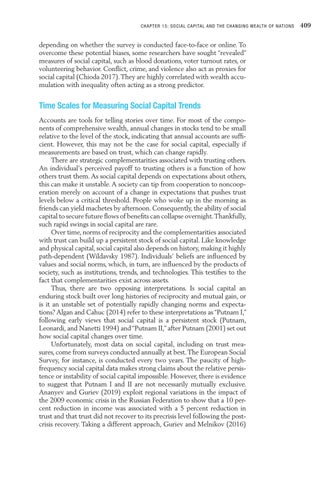CH AP TER 1 5 : SOC IAL C APITAL AND THE C HANGING W EALTH OF NATIONS
depending on whether the survey is conducted face-to-face or online. To overcome these potential biases, some researchers have sought “revealed” measures of social capital, such as blood donations, voter turnout rates, or volunteering behavior. Conflict, crime, and violence also act as proxies for social capital (Chioda 2017). They are highly correlated with wealth accumulation with inequality often acting as a strong predictor.
Time Scales for Measuring Social Capital Trends Accounts are tools for telling stories over time. For most of the components of comprehensive wealth, annual changes in stocks tend to be small relative to the level of the stock, indicating that annual accounts are sufficient. However, this may not be the case for social capital, especially if measurements are based on trust, which can change rapidly. There are strategic complementarities associated with trusting others. An individual’s perceived payoff to trusting others is a function of how others trust them. As social capital depends on expectations about others, this can make it unstable. A society can tip from cooperation to noncooperation merely on account of a change in expectations that pushes trust levels below a critical threshold. People who woke up in the morning as friends can yield machetes by afternoon. Consequently, the ability of social capital to secure future flows of benefits can collapse overnight. Thankfully, such rapid swings in social capital are rare. Over time, norms of reciprocity and the complementarities associated with trust can build up a persistent stock of social capital. Like knowledge and physical capital, social capital also depends on history, making it highly path-dependent (Wildavsky 1987). Individuals’ beliefs are influenced by values and social norms, which, in turn, are influenced by the products of society, such as institutions, trends, and technologies. This testifies to the fact that complementarities exist across assets. Thus, there are two opposing interpretations. Is social capital an enduring stock built over long histories of reciprocity and mutual gain, or is it an unstable set of potentially rapidly changing norms and expectations? Algan and Cahuc (2014) refer to these interpretations as “Putnam I,” following early views that social capital is a persistent stock (Putnam, Leonardi, and Nanetti 1994) and “Putnam II,” after Putnam (2001) set out how social capital changes over time. Unfortunately, most data on social capital, including on trust measures, come from surveys conducted annually at best. The European Social Survey, for instance, is conducted every two years. The paucity of highfrequency social capital data makes strong claims about the relative persistence or instability of social capital impossible. However, there is evidence to suggest that Putnam I and II are not necessarily mutually exclusive. Ananyev and Guriev (2019) exploit regional variations in the impact of the 2009 economic crisis in the Russian Federation to show that a 10 percent reduction in income was associated with a 5 percent reduction in trust and that trust did not recover to its precrisis level following the postcrisis recovery. Taking a different approach, Guriev and Melnikov (2016)
409


